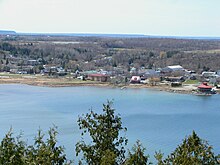|
Manitoulin District
Manitoulin District is a district in Northeastern Ontario within the Canadian province of Ontario. It was created in 1888 from part of the Algoma District. The district seat is in Gore Bay. It comprises Manitoulin Island primarily, as well as a number of smaller islands surrounding it, such as Barrie, Cockburn, and Great La Cloche islands. Previously it included the municipality of Killarney on the mainland, until this was transferred to Sudbury District in the late 1990s. Subsequently, more mainland portions were added to Killarney and these, together with Unorganized Mainland Manitoulin District, were also transferred to Sudbury District in 2006, about 1,600 square kilometres (600 sq mi) in all.[2] GeographyThe district has an area of 3,073.54 square kilometres (1,186.70 sq mi),[1] making it the smallest district in Ontario. It is in the northern part of Lake Huron, separated from the mainland by the North Channel to the north and by the Georgian Bay to the east. Islands included within the district are:[3]
Subdivisions Towns: Townships:
Unorganized areas:
First NationsReserves:
Communities
DemographicsAs a census division in the 2021 Census of Population conducted by Statistics Canada, the Manitoulin District had a population of 13,935 living in 6,144 of its 9,302 total private dwellings, a change of 5.1% from its 2016 population of 13,255. With a land area of 3,073.54 km2 (1,186.70 sq mi), it had a population density of 4.5/km2 (11.7/sq mi) in 2021.[1] Canada census – Manitoulin District community profile
ServicesLike the other districts of Northern Ontario, the Manitoulin District does not have a county or regional municipality tier of government. All services in the district are provided either by the individual municipalities or directly by the provincial government. Services are provided jointly with the Sudbury District from its district seat in Espanola. TransportationKing's Highways: Secondary Highways: MediaThe district is served by two weekly community newspapers, the Manitoulin Expositor in Little Current and the Manitoulin West Recorder in Gore Bay; the papers are sister publications both owned and operated by the McCutcheon family. The district is served by the commercial radio stations CFRM-FM and CHAW-FM, the First Nations community radio station CHYF-FM, and the Elliot Lake-based commercial radio station CKNR-FM. It is otherwise primarily served by media from Sudbury, including the Sudbury Star and CTV Northern Ontario. See also
References
External linksWikimedia Commons has media related to Manitoulin District. |
|||||||||||||||||||||||||||||||||||||||||||||||||||||||||||||||||||||||||||||||||||||||||||||||||||||||||||||||||||||||||||||||||||||||||||||
Portal di Ensiklopedia Dunia

